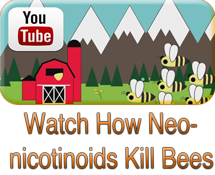Subchronic exposure of honeybees to sublethal doses of pesticides: effects on behavior
Abstract
Laboratory bioassays were conducted to evaluate the effects on honeybee behavior of sublethal doses of insecticides chronically administered orally or by contact. Emergent honeybees received a daily dose of insecticide ranging from one-fifth to one-five-hundredth of the median lethal dose (LD50) during 11 d. After exposure to fipronil (0.1 and 0.01 ng/bee), acetamiprid (1 and 0.1 microg/bee), or thiamethoxam (1 and 0.1 ng/bee), behavioral functions of honeybees were tested on day 12. Fipronil, used at the dose of 0.1 ng/bee, induced mortality of all honeybees after one week of treatment. As a result of contact treatment at 0.01 ng/bee, honeybees spent significantly more time immobile in an open-field apparatus and ingested significantly more water. In the olfactory conditioning paradigm, fipronil-treated honeybees failed to discriminate between a known and an unknown odorant. Thiamethoxam by contact induced either a significant decrease of olfactory memory 24 h after learning at 0.1 ng/bee or a significant impairment of learning performance with no effect on memory at 1 ng/bee. Responsiveness to antennal sucrose stimulation was significantly decreased for high sucrose concentrations in honeybees treated orally with thiamethoxam (1 ng/bee). The only significant effect of acetamiprid (administered orally, 0.1 microg/bee) was an increase in responsiveness to water. The neonicotinoids acetamiprid and thiamethoxam tested at the highest dose (one-tenth and one-fifth of their oral LD50, respectively) and fipronil at one-five-hundredth of LD50 have limited effects on the motor, sensory, and cognitive functions of the honeybee. Our data on the intrinsic toxicity of the compounds after chronic exposure have to be taken into account for evaluation of risk to honeybees in field conditions.
Aliouane Y, El Hassani AK, Gary V, Armengaud C, Lambin M, Gauthier M. Environ Toxicol Chem. 2009 Jan;28(1):113-22. doi: 10.1897/08-110.1.
Subchronic exposure of honeybees to sublethal doses of pesticides: effects on behavior.
A common pesticide decreases foraging success and survival in honey bees
Abstract
Nonlethal exposure of honey bees to thiamethoxam (neonicotinoid systemic pesticide) causes high mortality due to homing failure at levels that could put a colony at risk of collapse. Simulated exposure events on free-ranging foragers labeled with a radio-frequency identification tag suggest that homing is impaired by thiamethoxam intoxication. These experiments offer new insights into the consequences of common neonicotinoid pesticides used worldwide.
Henry M, Béguin M, Requier F, Rollin O, Odoux JF, Aupinel P, Aptel J, Tchamitchian S, Decourtye A. Science. 2012 Apr 20;336(6079):348-50. doi: 10.1126/science.1215039. Epub 2012 Mar 29.
Field trial for evaluating the effects on honeybees of corn sown using Cruiser and Celest xl treated seeds
Abstract
A first field study was conducted to investigate the possible adverse effects that seeds dressed with neonicotinoid insecticides pose to honeybees during sowing. It was observed that in the exposure hives bee mortality increased on the day of sowing and that the number of foraging bees decreased the days after the sowing. The corn sowing posed a significant threat to honeybees, with thiamethoxam being the most probable toxic agent. A theoretical contact exposure was calculated for a bee when flying over the sown fields, revealing a dose of 9.2 ng bee(-1) close to the contact LD(50) of thiamethoxam.
Assessment of the environmental exposure of honeybees to particulate matter containing neonicotinoid insecticides coming from corn coated seeds (2)
Abstract
Since seed coating with neonicotinoid insecticides was introduced in the late 1990s, European beekeepers have reported severe colony losses in the period of corn sowing (spring). As a consequence, seed-coating neonicotinoid insecticides that are used worldwide on corn crops have been blamed for honeybee decline. In view of the currently increasing crop production, and also of corn as a renewable energy source, the correct use of these insecticides within sustainable agriculture is a cause of concern. In this paper, a probable--but so far underestimated--route of environmental exposure of honeybees to and intoxication with neonicotinoid insecticides, namely, the atmospheric emission of particulate matter containing the insecticide by drilling machines, has been quantitatively studied. Using optimized analytical procedures, quantitative measurements of both the emitted particulate and the consequent direct contamination of single bees approaching the drilling machine during the foraging activity have been determined. Experimental results show that the environmental release of particles containing neonicotinoids can produce high exposure levels for bees, with lethal effects compatible with colony losses phenomena observed by beekeepers.
Tapparo A, Marton D, Giorio C, Zanella A, Soldà L, Marzaro M, Vivan L, Girolami V.
Environ Sci Technol. 2012 Mar 6;46(5):2592-9. doi: 10.1021/es2035152. Epub 2012 Feb 17.

